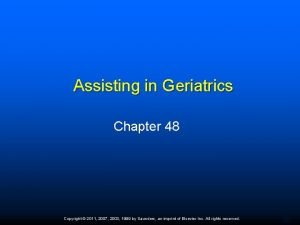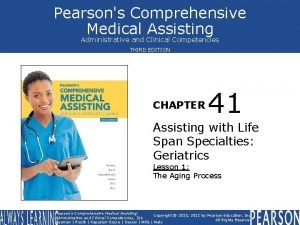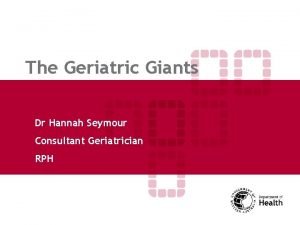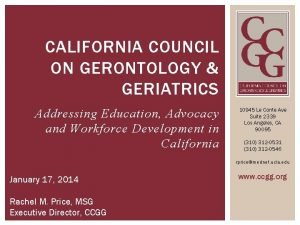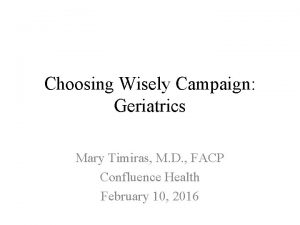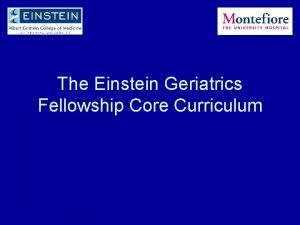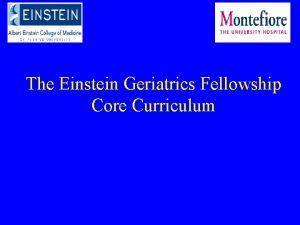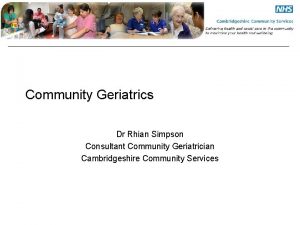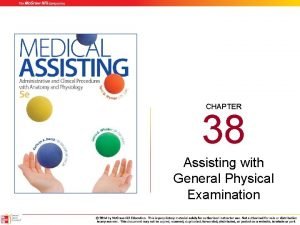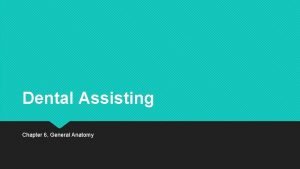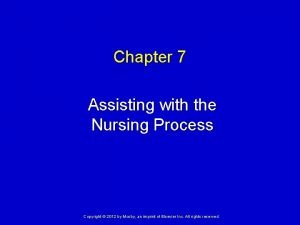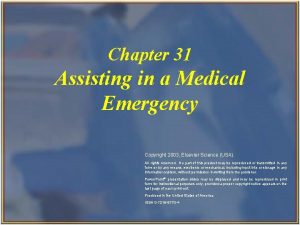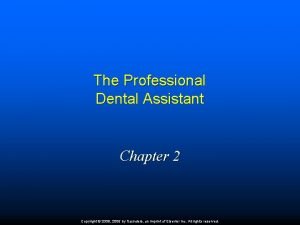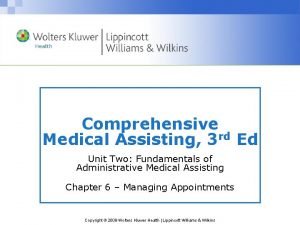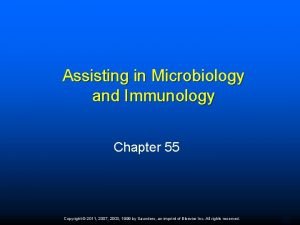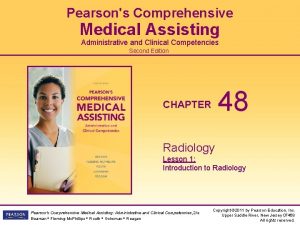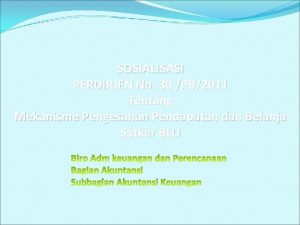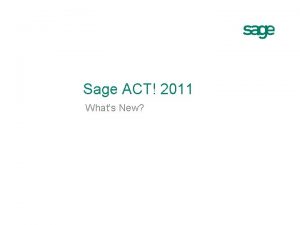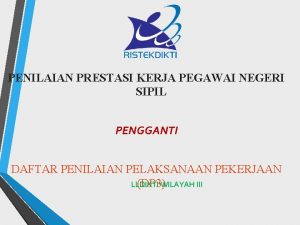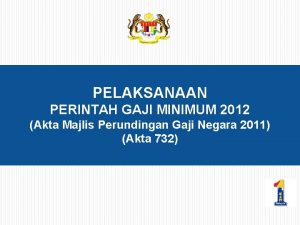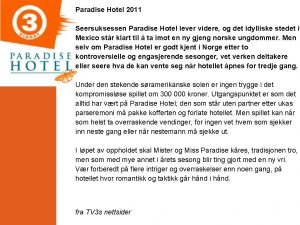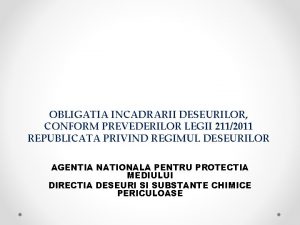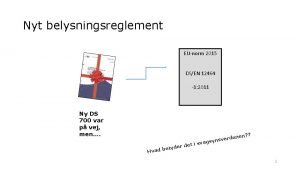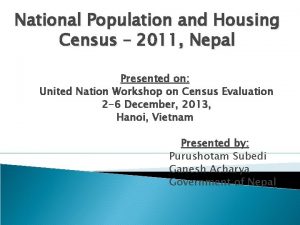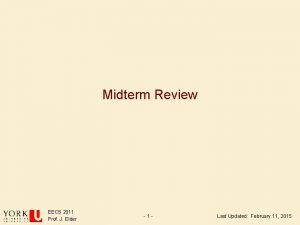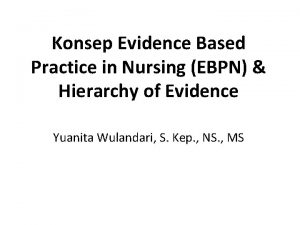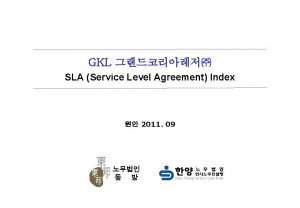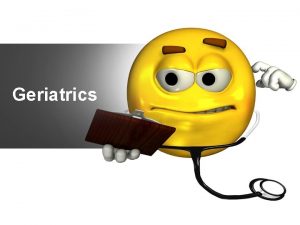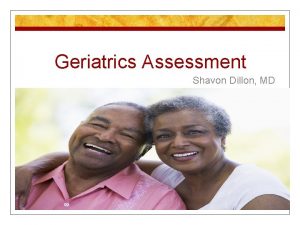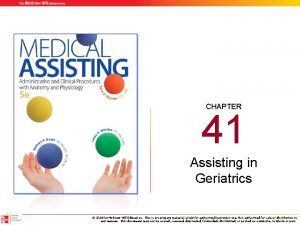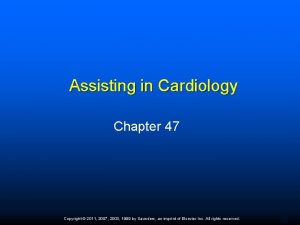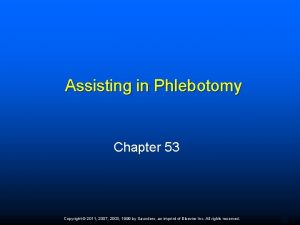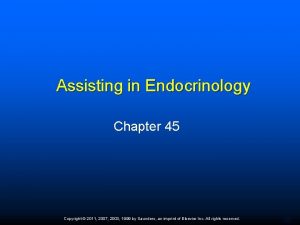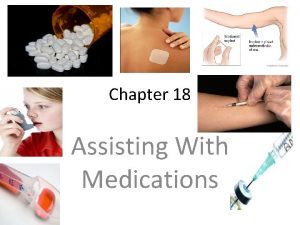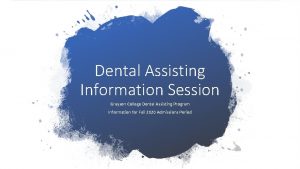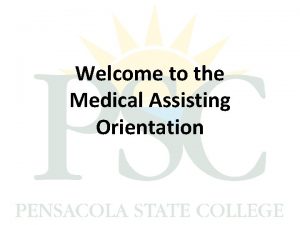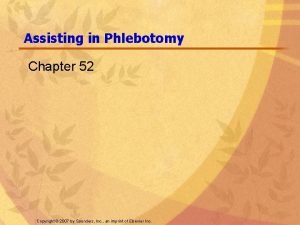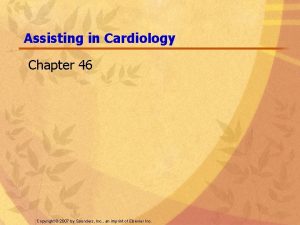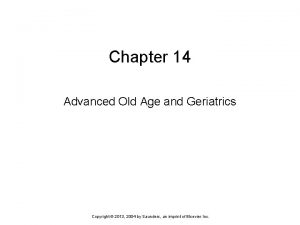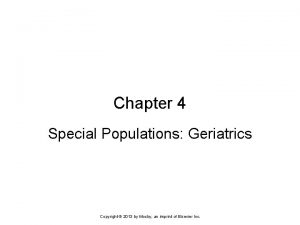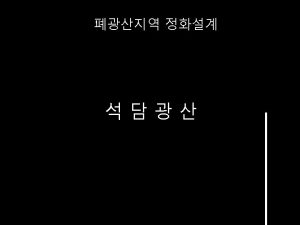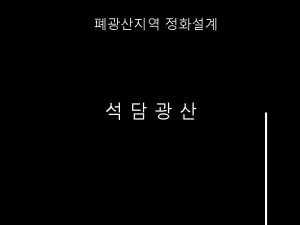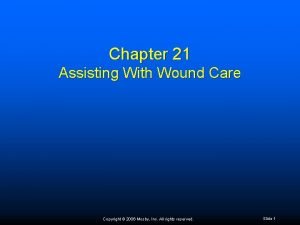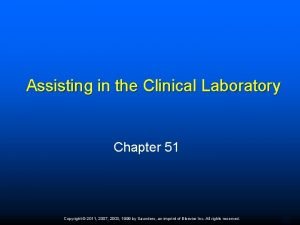Assisting in Geriatrics Chapter 48 Copyright 2011 2007





















































- Slides: 53

Assisting in Geriatrics Chapter 48 Copyright © 2011, 2007, 2003, 1999 by Saunders, an imprint of Elsevier Inc. All rights reserved. 1

Learning Objectives Define, spell, and pronounce the terms listed in the vocabulary. Apply critical thinking skills in performing patient assessment and care. Discuss the impact of a growing aging population on society. Role-play the effect of sensorimotor changes of aging. Explain the changes caused by aging in each of the body systems. Copyright © 2011, 2007, 2003, 1999 by Saunders, an imprint of Elsevier Inc. All rights reserved. 2

Learning Objectives Summarize the major diseases and disorders faced by older patients. Describe various screening tools for dementia, depression, and malnutrition. Explain the effect of aging on sleep. Differentiate among independent, assisted, and skilled nursing facilities. Copyright © 2011, 2007, 2003, 1999 by Saunders, an imprint of Elsevier Inc. All rights reserved. 3

Learning Objectives Summarize the role of the medical assistant in caring for aging patients. Determine the principles for effective communication with older adults. Identify legal and ethical issues regarding aging patients. Copyright © 2011, 2007, 2003, 1999 by Saunders, an imprint of Elsevier Inc. All rights reserved. 4

Aging Population According to the Administration on Aging, the aging population—those 65 years of age and older—numbered almost 37. 3 million in 2006. The “oldest old” (people older than 85) comprise the most rapidly growing age group. It is projected that people older than 65 years will represent 16% of the population in 2020 and increase to 20% by 2030. Copyright © 2011, 2007, 2003, 1999 by Saunders, an imprint of Elsevier Inc. All rights reserved. 5

Older Population by Age, 1900– 2030 From the U. S. Administration on Aging. Available at: www. aaa. gov. Copyright © 2011, 2007, 2003, 1999 by Saunders, an imprint of Elsevier Inc. All rights reserved. 6

Aging Health Problems The most frequently occurring health problems seen in the elderly: Hypertension, arthritis, heart disease, cancer, and diabetes Ø Significant numbers also suffer from strokes, asthma, emphysema, and chronic bronchitis Ø Copyright © 2011, 2007, 2003, 1999 by Saunders, an imprint of Elsevier Inc. All rights reserved. 7

Services for the Aging The aging process includes physical and sensory changes in older people. The healthcare professional recognizes the special needs of the aged and develops effective management and communication skills for better service for the older client. Copyright © 2011, 2007, 2003, 1999 by Saunders, an imprint of Elsevier Inc. All rights reserved. 8

Myths about Aging Senility inevitable Disease unavoidable Older workers less productive Long-term care inevitable No interest in or ability for sexual relations Resistant to change Cannot learn new things Copyright © 2011, 2007, 2003, 1999 by Saunders, an imprint of Elsevier Inc. All rights reserved. 9

Critical Thinking Application When Bill first started working with aging patients, he believed many of the stereotypes regarding persons over the age of 65 years. Since working with Dr. Kennedy, he realizes that many of these myths have no foundation in actual practice. Based on the myths mentioned in the text, what do you think about these beliefs on aging? Copyright © 2011, 2007, 2003, 1999 by Saunders, an imprint of Elsevier Inc. All rights reserved. 10

Aging Changes Table 48 -1 in your textbook summarizes the changes in anatomy and physiology associated with aging in all body systems. Normal age-related changes can be expected and compensated for, but these become more serious in the presence of poor health habits and chronic disease. Copyright © 2011, 2007, 2003, 1999 by Saunders, an imprint of Elsevier Inc. All rights reserved. 11

Aging Changes General changes include: An increase in arteriosclerosis Ø An increase in time needed to learn new material Ø A sharp decline in estrogen for women and increased risk of osteoporosis Ø An increase in malabsorption problems and constipation Ø A decrease in muscle mass Ø Less elasticity in lungs and gradual stiffening of the chest wall Ø A tendency to gain weight Ø Copyright © 2011, 2007, 2003, 1999 by Saunders, an imprint of Elsevier Inc. All rights reserved. 12

Aging Changes A deterioration of joint cartilage Ø Presbycusis and presbyopia Ø An enlargement of the prostate and weakened bladder muscles Ø Impotence not a symptom of normal aging Ø Menopause causes vaginal narrowing and dryness Ø Copyright © 2011, 2007, 2003, 1999 by Saunders, an imprint of Elsevier Inc. All rights reserved. 13

Management of Changes Age-related changes can be managed through: Regular aerobic exercise and strength training Ø Weight control Ø A diet rich in fruits, vegetables, and whole grains and low in fat Ø Avoidance of sun damage to skin Ø Pelvic muscle exercises Ø Annual physical examinations with health screening Ø Copyright © 2011, 2007, 2003, 1999 by Saunders, an imprint of Elsevier Inc. All rights reserved. 14

Health Issues The major health issues for aging people are related to an increase in atherosclerosis and potential cardiovascular disease. Hypertension Ø Type 2 diabetes mellitus Ø Tendency to hyperthermia and hypothermia Ø Seborrheic keratosis Ø Arthritis Ø Osteoporosis Ø Ø Increased risk of injury from falls Copyright © 2011, 2007, 2003, 1999 by Saunders, an imprint of Elsevier Inc. All rights reserved. 15

Cardiovascular System and Aging Most frequent cause of death, illness, and disability. CHF most common reason for hospitalization. Aging causes structural changes in the heart. Heart rate decreases. Heart has to work harder to circulate blood through calcified vessels. Increased incidence of orthostatic hypotension. Copyright © 2011, 2007, 2003, 1999 by Saunders, an imprint of Elsevier Inc. All rights reserved. 16

Shingles Management Zostavax vaccine is available to reduce the risk of shingles in people 60 years of age and older. The varicella-zoster virus causes both shingles and chickenpox; after an active chickenpox infection the virus lies dormant in a nerve dermatome. As people age, they are at risk of the virus reactivating and causing the formation of shingles. Administered as a single subcutaneous injection. Recommended that all individuals over the age of 60 years receive the Zostavax vaccination. Copyright © 2011, 2007, 2003, 1999 by Saunders, an imprint of Elsevier Inc. All rights reserved. 17

Endocrine System Most common problem is diabetes type 2 10% over age 60 Causes increased risk for multiple health problems Patients display different symptoms because of insidious onset—weight loss, slow wound healing, recurrent infections, changes in mental state, cataracts, macular disease, muscle weakness, angina, foot ulcers, uremia Patient education is essential What teaching adaptations may be needed? Copyright © 2011, 2007, 2003, 1999 by Saunders, an imprint of Elsevier Inc. All rights reserved. 18

Factors That Can Affect Diabetes Management Modifying lifestyle risk factors may be more difficult because of poor nutrition, inability to exercise, and long-standing habits such as smoking and diets high in fat and calories. Previously diagnosed health conditions, such as hypertension and heart disease, and age-related declines in kidney and liver function increase the challenge of treating diabetes. Older people are more likely to be prescribed multiple medications (polypharmacy), which increases the risk of adverse drug interactions. Copyright © 2011, 2007, 2003, 1999 by Saunders, an imprint of Elsevier Inc. All rights reserved. 19

Factors That Can Affect Diabetes Management Elderly diabetics are more prone to hypoglycemia and may not recognize and respond quickly to the signs of low blood glucose levels. Diabetic complications can develop quickly because of a long history of prediabetes before diagnosis. Older people may have decreased physical and/or mental abilities that make it difficult for them to understand adhere to a complicated treatment regimen. Older patients may not be able to afford the medications and supplies needed to maintain health. Copyright © 2011, 2007, 2003, 1999 by Saunders, an imprint of Elsevier Inc. All rights reserved. 20

Gastrointestinal System Decrease in HCl affects digestion of calcium and iron Decrease in intrinsic factor causes fatigue Increased rate of passage through small intestine causes poor absorption of vitamins and minerals Poor eating habits, reduced fluid intake, and some medications contribute to constipation Liver size decreases in size and weight after age 70 years Increase in the incidence of GI diseases such as GERD, peptic ulcers, diverticulosis, cholelithiasis, and colorectal cancer Copyright © 2011, 2007, 2003, 1999 by Saunders, an imprint of Elsevier Inc. All rights reserved. 21

Integumentary System Age-related changes and sun exposure combine to cause changes in appearance and function. Terms: seborrheic keratosis and alopecia. Epidermis reproduces more slowly, so skin appears thinner, tends to tear; increased bruising, infections. Why is there decreased vitamin D synthesis and increased photosensitivity? Dermis loses 20% of mass: Vascular supply and SC layer decrease Ø Hypothermia and hyperthermia Ø Increased pain tolerance Ø How can the elderly prevent and treat dry skin? Ø Copyright © 2011, 2007, 2003, 1999 by Saunders, an imprint of Elsevier Inc. All rights reserved. 22

Treating/Preventing Dry Skin A room humidifier to moisten the air Bathe less frequently, using warm rather than hot water Use a mild soap or cleansing cream such as Aveeno, Basis, or Dove Wear protective clothing in cold weather Moisturize dry skin Creams and moisturizers should be applied after getting out of the bathtub or shower to decrease the possibility of falls Copyright © 2011, 2007, 2003, 1999 by Saunders, an imprint of Elsevier Inc. All rights reserved. 23

Musculoskeletal System Muscular changes related to activity level. How can the MA help prevent falls? Ø Why are aging people at greater risk for injuries from falls? Osteoporosis causes hip and vertebral fractures. What are common risk factors? Ø What are methods of prevention and treatment? Ø Copyright © 2011, 2007, 2003, 1999 by Saunders, an imprint of Elsevier Inc. All rights reserved. 24

Helping Patients with Musculoskeletal Conditions Use assistive devices Assist with gripping as needed Older adults may need more time to complete tasks but prefer to do so independently, so slow down. Stroke victims should be supported on the weak side when walking or transferring from chair to examination table. Physician may recommend physical therapy for range-of-motion exercises. Encourage activity Copyright © 2011, 2007, 2003, 1999 by Saunders, an imprint of Elsevier Inc. All rights reserved. 25

Osteoporosis Risk Factors Female (women have a five times greater risk than men) Small-boned frame, thin Family history of osteoporosis Estrogen deficiency before age 45 years Racial background—white and Asian women at highest risk Aging Anticonvulsant drugs, prednisone, and thyroid hormone medications Sedentary lifestyle, smoking, excessive alcohol intake, lack of calcium and vitamin D Copyright © 2011, 2007, 2003, 1999 by Saunders, an imprint of Elsevier Inc. All rights reserved. 26

Preventing Falls Hearing and vision testing to be aware of possible dangers Understand the side effects of medications With orthostatic hypotension, rise slowly and still for a moment Limit alcohol Consistently use assistive devices Wear low-heeled, rubber-soled shoes with good support Avoid going outside in icy weather Engage in regular weight-bearing exercise Keep hallways, stairs, and bathrooms well lit Assess home for possible danger areas; remove throw rugs; use handrails on steps and grab bars in bathrooms; keep emergency numbers handy Copyright © 2011, 2007, 2003, 1999 by Saunders, an imprint of Elsevier Inc. All rights reserved. 27

Critical Thinking Application The family of a 73 -year-old patient, Mrs. Rita Schaeffer, is concerned about the risk of falls. Mrs. Schaeffer was recently diagnosed with osteoporosis and lives alone. What information should Bill give the family to help them prevent accidents in their mother’s home? Her 43 -year-old daughter is concerned about developing osteoporosis as well. What methods should the daughter employ to prevent the disease? Copyright © 2011, 2007, 2003, 1999 by Saunders, an imprint of Elsevier Inc. All rights reserved. 28

Nervous System What affects cognitive ability? Is dementia inevitable? What can cause signs and symptoms of dementia? What is the best method for maintaining mental function? What are risk factors for cognitive decline? Copyright © 2011, 2007, 2003, 1999 by Saunders, an imprint of Elsevier Inc. All rights reserved. 29

Signs and Symptoms of Alzheimer’s Disease Repeatedly asking the same questions Unable to remember common words or mixing words up when describing something Unable to complete simple tasks and misplacing items Getting lost when driving familiar routes Sudden mood swings for no apparent reason Difficulty following simple directions Copyright © 2011, 2007, 2003, 1999 by Saunders, an imprint of Elsevier Inc. All rights reserved. 30

Alzheimer’s Disease Progressive deterioration of the brain because of amyloid plaques and neurofibrillary tangles First rule out other organic causes What medications are used for treatment? Stages: First— 2– 4 years before diagnosis; memory loss, confusion, disorientation, withdrawal Ø Second— 2– 10 years after diagnosis; increased symptoms, restless, repetitive statements, mood changes, motor problems. Ø Third—lasts 1– 3 years; weight loss, does not recognize family, incontinent, requires complete care Ø Copyright © 2011, 2007, 2003, 1999 by Saunders, an imprint of Elsevier Inc. All rights reserved. 31

Critical Thinking Application Maria Angelone is an 86 -year-old patient of Dr. Kennedy who is in the second stage of AD. Her husband children are showing signs of stress from the continuous care required by Mrs. Angelone. Her family still does not understand what is happening to her and what to expect in the future. What information can Bill share with them about the disease, and what resources could be helpful to the family in dealing with the stress of caring for a loved one with dementia? Copyright © 2011, 2007, 2003, 1999 by Saunders, an imprint of Elsevier Inc. All rights reserved. 32

Pulmonary System Maximum lung function decreases with age Lungs lose elasticity; alveoli enlarge; number of capillaries is reduced Ribs and vertebrae stiffen; respiratory muscles weaken making it harder to cough deeply enough to clear mucus from lungs Sleep apnea and sleep disorders increase All of these factors combine to put older adults at greater risk for pneumonia and aspiration as well as reactivation of TB Larynx changes cause a change in the pitch and quality of the voice Copyright © 2011, 2007, 2003, 1999 by Saunders, an imprint of Elsevier Inc. All rights reserved. 33

Vision Changes Presbyopia Cataracts Decreased lacrimation Glaucoma Macular degeneration Color blindness Decreased depth perception Nyctalopia Need six times as much light and have difficulty with glare How can the MA help? Copyright © 2011, 2007, 2003, 1999 by Saunders, an imprint of Elsevier Inc. All rights reserved. 34

Assisting Visually Impaired Patients When escorting an older person allow the client to place his or her hand above your elbow. Use high levels of evenly distributed glare-free light. Ask the pharmacist to use large lettering when labeling medicine bottles. Use paper that has a nonglare finish, and use large print forms. Make distinct differences (e. g. , size of containers or color-coding with bright primary colors) for pills that are similar in size and color. Place all objects within the visual field and avoid clutter. Copyright © 2011, 2007, 2003, 1999 by Saunders, an imprint of Elsevier Inc. All rights reserved. 35

Hearing Changes Presbycusis and depression Tinnitus How can the MA interact effectively with a hearing-impaired aging person? What type of questions are asked in the Geriatric Depression Scale? Copyright © 2011, 2007, 2003, 1999 by Saunders, an imprint of Elsevier Inc. All rights reserved. 36

Assisting Hearing-Impaired Patients Stand in the patient’s direct line of vision and gently touch the person to get attention. Use gestures, pictures, and large, bold print. Talk in short sentences into the ear with better hearing. Do not increase the volume of your speech. Use expanded speech—lower the tone of your voice and talk in distinct syllables. Avoid background noise. Check to see if hearing aid is on. Copyright © 2011, 2007, 2003, 1999 by Saunders, an imprint of Elsevier Inc. All rights reserved. 37

Nutritional Status Comprehensive interview should consider: Oral health Ø GI complaints Ø Sensorimotor changes Ø Financial considerations Ø Disease-related diet restrictions Ø Alcohol consumption Ø Depression Ø Support systems Ø Copyright © 2011, 2007, 2003, 1999 by Saunders, an imprint of Elsevier Inc. All rights reserved. 38

Urinary System Decreased blood flow and decreased number of nephrons cause kidneys to be less efficient at filtering waste from blood Structural changes in the bladder lead to increased frequency of urination and urinary retention Changes in the urinary system make older persons more vulnerable to incontinence, but factors such as infection, confusion, difficulty with mobility, and side effects from medications contribute to the development of the problem Copyright © 2011, 2007, 2003, 1999 by Saunders, an imprint of Elsevier Inc. All rights reserved. 39

Additional System Issues Pneumonia, aspiration, and reactivation of tuberculosis Ø Malnutrition Ø Increased urinary tract infections, incontinence, and prostate enlargement Ø Menopausal changes in the vaginal mucosa Ø Sleep disorders such as apnea and periodic limb movement disorder (PLMD) Ø Impact of medications on general health Ø Copyright © 2011, 2007, 2003, 1999 by Saunders, an imprint of Elsevier Inc. All rights reserved. 40

MMSE A commonly used screening tool for dementia is the Folstein Mini Mental Status Exam It is a 5 -minute screening test to evaluate basic mental function in the patient’s ability to recall facts, to write, and to calculate numbers, to determine if more in-depth testing is needed. Copyright © 2011, 2007, 2003, 1999 by Saunders, an imprint of Elsevier Inc. All rights reserved. 41

Depression To screen for depression the physician may use the Geriatric Depression Scale short form that questions the patient about daily activities, interests, and feelings. Nutritional status can be assessed through a comprehensive patient interview that considers all potential barriers to adequate nutrition. Copyright © 2011, 2007, 2003, 1999 by Saunders, an imprint of Elsevier Inc. All rights reserved. 42

Nutritional Status The nutritional status of older patients involves: Oral health Gastrointestinal (GI) complaints Sensorimotor changes Diet influences Social and mental influences Copyright © 2011, 2007, 2003, 1999 by Saunders, an imprint of Elsevier Inc. All rights reserved. 43

Sleep Problems Complaints of sleeping difficulties increase with age. Sleeping time may be slightly longer, but the quality of sleep decreases. Older people are often light sleepers and have periods of wakefulness in bed. Other factors influencing sleep patterns are medications, caffeine, alcohol, depression, and environmental or physical changes. Common sleep problems in older adults include PLMD and sleep apnea. Copyright © 2011, 2007, 2003, 1999 by Saunders, an imprint of Elsevier Inc. All rights reserved. 44

Caregivers Aging persons prefer to remain in their homes as long as possible. Adult day care centers can provide supervision for older adults who are taken care of by family members in the evening. They also provide respite for a caregiver. Copyright © 2011, 2007, 2003, 1999 by Saunders, an imprint of Elsevier Inc. All rights reserved. 45

Assisted Living Assisted-living facilities are appropriate for older adults who need assistance with some activities of daily living, such as bathing, dressing, and walking. Skilled nursing facilities provide 24 -hour medical care and supervision. In addition to medical care, residents receive physical, personal, occupational, and speech therapy. Copyright © 2011, 2007, 2003, 1999 by Saunders, an imprint of Elsevier Inc. All rights reserved. 46

Medical Assistant’s Role Develop effective communication skills reflective of age-related sensorimotor changes. For independence to be reinforced, aging patients require more time and should be scheduled for longer appointments. Copyright © 2011, 2007, 2003, 1999 by Saunders, an imprint of Elsevier Inc. All rights reserved. 47

Elder Care Considerations Provide adequate lighting in the waiting room, with forms in large print Make certain the examination room is equipped with furniture, magazines, and treatment folders especially designed for the elderly patient Have a professional in the management of the elderly patient provide in-service training to improve the quality of elder care. Copyright © 2011, 2007, 2003, 1999 by Saunders, an imprint of Elsevier Inc. All rights reserved. 48

Therapeutic Communication Ask the patient directly what is wrong rather than discussing the patient with family members. Give the patient your full attention rather than continuing with multiple tasks while he or she is speaking. Older people may take a little longer to process information, but they are capable of understanding. Do not hurry through explanations or questions, but take time to review a form or give instructions. Use referrals and community resources for patient and family support. Copyright © 2011, 2007, 2003, 1999 by Saunders, an imprint of Elsevier Inc. All rights reserved. 49

Therapeutic Communication Address the patient with an appropriate title. Introduce yourself and explain the purpose of a procedure before touching the patient. Establish eye contact and get the patient’s attention before beginning to speak. Use expanded speech, gestures, demonstrations, or written instructions in block print. Copyright © 2011, 2007, 2003, 1999 by Saunders, an imprint of Elsevier Inc. All rights reserved. 50

Therapeutic Communication Repeat the message as needed for understanding. Observe the patient’s nonverbal behaviors as cues to indicate if he or she understands. Allow time to process information. Avoid distractions. Involve family members as needed. Copyright © 2011, 2007, 2003, 1999 by Saunders, an imprint of Elsevier Inc. All rights reserved. 51

Advance Directives Provide written instructions specifying the type of medical care a person wishes to receive in the event she or he becomes incapacitated Designates someone as durable power of attorney —an authorization for making medical decisions if that individual is unable to make his or her own treatment decisions Provides a list of specific instructions for a proxy to follow – DNR orders; use of life-sustaining treatments Copy should be included in patient’s medical record Copyright © 2011, 2007, 2003, 1999 by Saunders, an imprint of Elsevier Inc. All rights reserved. 52

Identifying Elder Abuse Poor general appearance and poor hygiene Pattern of changing doctors and frequent emergency room visits Skin lesions, signs of dehydration, bruises (signs of new and old bruising together), abrasions, welts, burns, or pressure sores Recurrent injuries caused by accidents Signs of malnutrition and weight loss without related illness Any injury that does not fit the given history Copyright © 2011, 2007, 2003, 1999 by Saunders, an imprint of Elsevier Inc. All rights reserved. 53
 Chapter 41 assisting in geriatrics
Chapter 41 assisting in geriatrics Pearson's comprehensive medical assisting
Pearson's comprehensive medical assisting Giants of geriatrics
Giants of geriatrics California council on gerontology and geriatrics
California council on gerontology and geriatrics Choosing wisely geriatrics
Choosing wisely geriatrics Einstein geriatrics
Einstein geriatrics Einstein geriatrics
Einstein geriatrics Community geriatrics
Community geriatrics Chapter 42 assisting in other medical specialties
Chapter 42 assisting in other medical specialties Chapter 38 assisting with a general physical examination
Chapter 38 assisting with a general physical examination Chapter 6 general anatomy
Chapter 6 general anatomy Chapter 5 assisting with the nursing process
Chapter 5 assisting with the nursing process Chapter 31 assisting in a medical emergency
Chapter 31 assisting in a medical emergency Chapter 2 the professional dental assistant
Chapter 2 the professional dental assistant Chapter 42 assisting in other medical specialties
Chapter 42 assisting in other medical specialties Copyright 2007
Copyright 2007 Copyright 2007
Copyright 2007 Rop medical assisting
Rop medical assisting Assisting guests
Assisting guests Verb form of advertisement
Verb form of advertisement Assisting in microbiology and immunology
Assisting in microbiology and immunology Pearsons
Pearsons Wyd madrid 2011
Wyd madrid 2011 Microsoft windows small business server 2011 essentials
Microsoft windows small business server 2011 essentials Small business server 2011 end of life
Small business server 2011 end of life Seitel public relations
Seitel public relations Uma equipe de cientistas lançará
Uma equipe de cientistas lançará Per-30/pb/2011
Per-30/pb/2011 Kidush shavuot
Kidush shavuot Dorothea puente
Dorothea puente Sage act 2011
Sage act 2011 Chemistry regents 2011
Chemistry regents 2011 2011-1989
2011-1989 Boardworks ltd 2011
Boardworks ltd 2011 Perfil de egreso primer grado primaria
Perfil de egreso primer grado primaria Pergub 140 tahun 2011
Pergub 140 tahun 2011 Perbedaan pp 46 tahun 2011 dengan pp 30 tahun 2019
Perbedaan pp 46 tahun 2011 dengan pp 30 tahun 2019 Usa infotehnoloog 1955-2011
Usa infotehnoloog 1955-2011 Majlis perundingan gaji negara
Majlis perundingan gaji negara Paradise hotel 2011
Paradise hotel 2011 Legea 211/2011
Legea 211/2011 Ds/en 12464-1:2011
Ds/en 12464-1:2011 National population and housing census 2011
National population and housing census 2011 Eecs2011
Eecs2011 Unieważnienie matury 2011
Unieważnienie matury 2011 Lof 2011
Lof 2011 How can you import your movie assets to wlmm
How can you import your movie assets to wlmm Photo
Photo Ebpn
Ebpn Hpec 2011
Hpec 2011 Firebase history
Firebase history Sla 2011
Sla 2011 Federal court rules 2011
Federal court rules 2011 Eecs 2011
Eecs 2011
